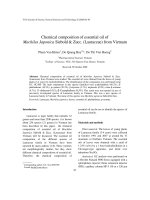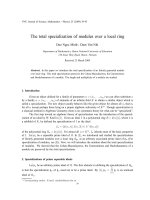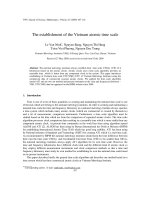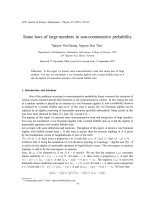Tài liệu Báo cáo " The effect of cobalt substitution on structure and magnetic properties of nickel ferrite " pptx
Bạn đang xem bản rút gọn của tài liệu. Xem và tải ngay bản đầy đủ của tài liệu tại đây (152.54 KB, 7 trang )
VNU Journal of Science, Mathematics - Physics 25 (2009) 153-159
153
The effect of cobalt substitution on structure
and magnetic properties of nickel ferrite
Nguyen Khanh Dung
1,
*, Nguyen Hoang Tuan
2
1
Industry University, Ho Chi Minh City,
12 Nguyen Van Bao, Ward 4, Go Vap District, Hochiminh city, Vietnam
2
Can Tho University, 3-2 Street, Can Tho city, Vietnam
Received 15 August 2009
Abstract. A series of cobalt doped nickel ferrite with composition of Ni
1-X
Co
X
Fe
2
O
4
with x ranges
from 0.0 to 0.8 (in steps of 0.2) was prepared by using co-precipitation method and subsequently
sintered, annealed at 600
0
C for 3h. The influence of the Co content on the crystal lattice parameter,
the stretching vibration and the magnetization of specimens were subsequently studied. XRD and
FTIR were used to investigate structure and composition variations of the samples. All samples
were found to have a cubic spinel structure. TEM was used to study morphological variations. The
results indicate that the average particle sizes are between 29÷35 nm. B-H hysteresis measurement
was carried out at room temperature under field of 5 kOe and this measurement with the increase
of Co
2+
concentration yields the monotonic increase of saturation magnetization (M
S
) and coercive
field (H
C
). Ferrites with such behavior are important for magnetic recording media, microwave
applications, environment and medical biology [1-3]. In view of this, we have studied the various
properties of Co doped Ni ferrite.
1. Introduction
NiFe
2
O
4
has cubic inverse spinel structure with Ni
2+
ions occupy octahedral B – site and Fe
3+
ions
occupy both tetrahedral A – sites and octahedral B – sites [4]. Nickel ferrite has been prepared by
standard ceramic route. That are particle size micrometer, low saturation magnetization and low
coercivity. To our knowledge, the systematic investigation of the magnetic and electrical properties of
Ni
1-X
Co
X
Fe
2
O
4
with x varied from 0 to 0.8 in steps of 0.2 has not been reported so far. Further Ni-Co
ferrite shows the good magnetostrictive properties among all the ferrite family. The studies on doping
of good magnetostrictive material into the highly resistive nickel ferrite is one of the important phase
for consideration of challenging magnetoelectric materials. Therefore by keeping this view in our
mind we have proposed the studies on structural analysis and magnetic properties of Co–Ni ferrite
with the above mentioned compositions by co – precipitation method, a new method for preparation of
ferrite [5-6].
The results shown prepared Ni
1-X
Co
X
Fe
2
O
4
powder ferrite had the particle sizes in nanometers and
good magnetic properties:
- Saturation Magnetization M
S
about 47-67 emu/g,
______
*
Corresponding author. E-mail:
N.K. Dung, N.H. Tuan / VNU Journal of Science, Mathematics - Physics 25 (2009) 153-159
154
- Coercivity H
C
from 31 Oe (with x=0.0) to 871 Oe (with x=0.8),
- Average longitudinal Magnetostriction λ
//
= (80-120).10
-6
- Magnetomechanic Quality Q=3100 (with x=0.0)
2. Experimental
2.1. Synthesis of Ni-Co powder ferrite
A series of cobalt doped nickel ferrite with composition of Ni
1-X
Co
X
Fe
2
O
4
with x ranges from 0.0
to 0.8 (in steps of 0.2) was prepared by co-precipitation method. For the sake of simplicity, the
samples are labeled viz. NF for x = 0.0, NFC02 for x = 0.2, NFC04 for x = 0.4, NFC06 for x = 0.6 and
NFC08 for x = 0.8. The chemical reagents used were NiCl
2
.6H
2
O, CoCl
2
.6H
2
O, FeCl
3
.6H
2
O. All the
chemicals were dissolved in water with Fe
3+
concentration of 0.8 mol, 0.4 mol of ions Co
2+
and Ni
2+
.
0.48 mol solution of sodium hydroxide was prepared and slowly added to the salt solution drop wise
with steady stirring. The reaction was performed at 80
0
C and pH values in the range (12-14) keep up
constant for three hours. A precipitation immediately formed in the solution:
0.8 NiCl
2
.6H
2
O + 0.2CoCl
2
.6H
2
O + 2Fe
2
Cl
3
.6H
2
O + 8NaOH
80
o
C
Ni
0.8
Co
0.2
Fe
2
O
4
+ 8NaCl + 22H
2
O
After the precipitation was taken by magnet and the product was washed several time with
distilled water. Finally it was annealed in oven at 600
0
C for 3 hours.
2.2. Measurements of properties of Ni-Co ferrite
The morphology of the samples was performed by X-ray diffractometer (XRD), Fourier transform
infrared (FT-IR) transmission spectra and Transmission Electron Microscope (TEM). Debey Scherrer
formula was used to determine the particle size of the prepared samples. The magnetic
characterization was performed by vibrating sample magnetometer (VSM).
3. Results and discussion
3.1. X-ray diffraction
X-ray powder diffraction (XRD) patterns of Ni
1
-
X
Co
X
Fe2O4 (with x = 0, 0.2, 0.4, 0.6, 0.8) are
shown in Fig. 1. From this Fig. the following reflection planes are showed: (111), (220), (311), (222),
(400), (422), (511) and (440). These planes are indications of the presence of a spinel cubic structure.
The diffraction lines corresponding to a cubic, spinel-type and crystalline phase provides clear
evidence of the formation of solid solution NiFe
2
O
4
.
N.K. Dung, N.H. Tuan / VNU Journal of Science, Mathematics - Physics 25 (2009) 153-159
155
(111)
(440)
(220)
(311)
(222)
(400)
(422)
(511)
Fig. 1. XRD powder diffraction patterns of Ni
1-x
Co
x
Fe
2
O
4
.
From Fig.2 it is observed that lattice parameter varies from 8.334 Å to 8.382 Å with increasing
Co
2+
content and they are tabulated in Table 1. This increase of lattice parameter with Co
2+
due to the
difference in ionic sizes of the component ions. The Co
2+
ions have larger ionic radius (0.78 Å) than
Ni
2+
(0.74 Å) and Fe
3+
(0.67 Å) ions.
Fig. 2. Lattice parameters of Ni
1-x
Co
x
Fe
2
O
4
.
Table 1. Calculated lattice parameter ‘a’, X-ray density ‘D
X
’, Actual density and Relative density
of Ni
1-x
Co
x
Fe
2
O
4
ferrites
Sample Particle size
(nm)
Lattice parameter
(A
0
)
X-ray density ‘D
X
’
(g/cm
3
)
Actual D’
x
(g/cm
3
)
Relative density
D’
X
/ ‘D’
X
(%)
NF 29 8.334 5.4 5.3 98.2
NFC02 33 8.343 5.4 5.2 96.3
NFC04 30 8.362 5.3 5.2 98.1
NFC06 33 8.371 5.3 5.2 98.1
NFC08 35 8.382 5.3 5.1 96.2
X = 0.8
X = 0.6
X = 0.4
X = 0.2
X = 0.0
110
100
90
80
70
60
50
40
30
20
10
0
10
20
30
40
50 60
2 Theta
-
Scale
Lattice parameters
(
Å
)
8.38
8.37
8.36
8.35
8.34
8.33
0.0 0.2 0.4
0.6 0.8 X
Lin (Cps)
N.K. Dung, N.H. Tuan / VNU Journal of Science, Mathematics - Physics 25 (2009) 153-159
156
The X-ray density or theoretical density was estimated by using the relation [6]:
X-ray density
∑
=
V.N
A
D
A
x
(1)
Where, A is the atomic weights of all the atoms in the unit cell, V is volume of the unit cell and N
is the Avogadro’s number.
Since each primitive unit cell of the spinel structure contains 8 molecules, the X-ray density, ‘D
X
’
was determined according to the following relation and is shown in Table1.
3
A
x
a.N
M8
D = (2)
Where, M is molecular weight of the particular ferrite, N
A
is the Avogadro’s number and a
3
is the
volume of the cubic unit cell.
From Fig.2, it is observed that X-ray density ‘D
x
’ decreases with addition of Co
2+
ion content,
which may be attributed to the ionic radii of constituent ions causing increase in lattice parameter and
the densities of pure cobalt ferrite (5.29 g/cm
3
) and pure nickel ferrite (5.38 g/cm
3
).
The obtained XRD patterns of the Ni-Co ferrites are shown in Fig.1. Consequently, one can obtain
the average particle size, from the broadening effect of the most intense peak employing the Scherrer
formula as [6],
θ
λ
=
θ
cosB
9.0
d
2
(3)
where B
2θ
is the full width half maximum (rad), λ the wavelength of the X-ray, θ the angle between
the incident and diffracted beams (degree) and d the particle size of the sample (nm) (in Table 1).
3.2. FT-IR spectroscopy
The band wavenumber v
1
, v
2
, (Table 2) generally observed in the range 600–550 cm
−
1
, corresponds
to an intrinsic stretching vibrations of the metal at the tetrahedral site, M
tetra
↔ O, whereas the v
2
-
lowest band, usually observed in the range 450–385 cm
−
1
, is assigned to octahedral-metal stretching,
M
octa
↔ O [6]. The decrease of wavenumber with the increase of Co
2+
is shown in Fig.3.
Table 2. The IR spectra analysis for the studied samples
Sample
ν
1
(cm
-1
) ν
2
(cm
-1
)
NF 596.15 428.12
NFC02 595.20 424.75
NFC04 595.37 420.65
NFC06 596.78 422.25
NFC08 593.02 420.72
N.K. Dung, N.H. Tuan / VNU Journal of Science, Mathematics - Physics 25 (2009) 153-159
157
Fig. 3. FT-IR spectra of ferrite NiFe
2
O
4
(left) and Ni
0.2
Co
0.8
Fe
2
O
4
(right).
3.3. TEM analysis
Fig. 4. TEM Micrograph of: (a) NiFe
2
O
4
, (b) Ni
0.4
Co
0.6
Fe
2
O
4
, (c) Ni
0.2
Co
0.8
Fe
2
O
4
annealed at 600
0
C.
TEM was used to investigate the morphology and micrographs of various samples. The
micrographs are shown in Fig.4. A broad size distribution is observed with 32 ± 3 nm.
Fig.5 shows hysteresis loops for Ni
1-x
Co
x
Fe
2
O
4
nanoparticles at room temperature.These plots
show that an increase in Co
2+
doping yields monotonic increase in the saturation magnetization of Ni-
ferrite which may be due to the substitution of Ni
2+
ions by Co
2+
on the octahedral sties. Therefore,
the increasing Co
2+
concentration (x) on the octahedral sites may result in an increasing magnetic
moment per formula of Ni
1-x
Co
x
Fe
2
O
4
and equivalently, an enhancement of magnetization [7].The
dependence of saturation magnetization M
s
as a function of Co
2+
concentration is shown in Fig.5. At
room temperature NiFe
2
O
4
shows a saturation magnetization M
S
= 35.3 (emu/g) while Ni
0.2
Co
0.8
Fe
2
O
4
exhibits M
S
= 60.1 (emu/g) (in table 3).
Table 3. Room temperature parameters: Saturation magnetization (M
S
), Coercivity (H
C
),
Remanent magnetization (M
r
), Anisotropy constant (K).
X H
C
(Oe) M
S
(emu/g) M
r
(emu/g) K (erg/g)
0.0 31 35.3 7.3 5.5.10
2
0.2 359 38.1 12.4 6.9.10
3
0.4 740 49.1 20.0 1.8.10
4
0.6 835 55.7 26.4 2.3.10
4
0.8 871 60.1 27.1 2.6.10
5
a
b
a
c
Transmittance [
%]
20 30 40 50 60 70 80 90100
Transmittance [
%]
20
30 40 50
60 70
80 90100
3500 3000 2500 2000 1500 1000 500
Wavenumber cm
-1
3500 3000 2500 2000 1500 1000 500
Wavenumber cm
-1
2007
1622
925
596
3369
1625
922
593
N.K. Dung, N.H. Tuan / VNU Journal of Science, Mathematics - Physics 25 (2009) 153-159
158
3.4. Magnetization measurements:
There will be a dependence of anisotropy constant K on the Co
2+
ion concentration x, which can be
evaluated by using the relation and is shown in table 3 with
2
MH
K
SC
= .
Magnetic structure of ferrite Ni
1-x
Co
x
Fe
2
O
4
is decribed following [8]:
Fe
3+
[ Ni
2+
1-x
Co
2+
x
Fe
3+
] O
2-
4
tetrahedral octahedral
The magnetic moment of a ion Co
2+
is equal to 3μB, during it is 2 μB for a ion Ni
2+
and 5 μB for
Fe
3+
. When x increased this leads to the compensation of ion Fe
3+
in the tetrahedral and octahedral
location. That led to increasing of total magnetization of a molecule Ni
1-x
Co
x
Fe
2
O
4
and hence there is
increasing of M
S
(table 3).
Another side, it is known that the magnetizing process of hard ferrite consisting of single domain
particles is the rotation process of magnetization vectors of domain, then coercivity is determined as
follows:
S
S
S21
S
1
C
M
τλ
c)MNb(N
M
K
aH +−+=
where a, b, c are constants; N
1
and N
2
are demagnetization factors determined along two perpendicular
directions; λ
S
– magnetostriction and τ- mechanical strain.
Magnetic field strength
(Oe
)
Magnetization (emu/g)
-
1
0000
-
5000 0 5000 10000
X= 0.8
X= 0.6
X= 0.4
X= 0.2
X= 0.0
60
40
20
0
-20
-40
-60
Fig. 5. Hysteresis loops for all samples of Ni
1-x
Co
x
Fe
2
O
4
ferrite system.
N.K. Dung, N.H. Tuan / VNU Journal of Science, Mathematics - Physics 25 (2009) 153-159
159
The first term in above expression corresponds to the contribution of magnetocrystalline
anisotropy of material, the second one is given by shape anisotropy of crystalline particles (domains)
and the third one is orginated from the action of elastic mechanical deformation. In fact, the first term
plays a decided role for creating high coercivity of materials, the second term can take part of several
tens percent of H
C
and the last one whereas can only reach several hundreds of gauss.
Thus, the increasing of Co-concentration led to the increasing of anisotropy property of ferrites
Ni
1-x
Co
x
Fe
2
O
4
, hence it was the increasing of H
C
.
The increasing of H
C
proved that the soft magnetic property of ferrite NiFe
2
O
4
changed to the hard
magnetic property of ferrite CoFe
2
O
4
.
Ni-Co ferrite samples manifested magnetostrictive property well. The longitudinal
magnetostriction ( was measured in accordance with sensor Wheaston bridge method [9] ) of
Ni
1-x
Co
x
Fe
2
O
4
ferrites was λ
//
= (80 -120).10
-6
(with x = 0.6 - 0.8).
The Magnetomechanic Quality was determinated by following expression:
FerCu
RR
L
Q
−
=
ω
, with
L is the electric induction of a coil torus, measured on the device 819 High Precision LCR Meter in
Institute of Physics in Ho Chi Minh City, ω is measured frequency, where valuable 700Hz; R
Cu
and
R
Fer
are the resistance of the copper coil without and with ferrite toroid core, measured by the method
for Wheaston bridge. The Magnetomechanic Quality of NiOFe
2
O
3
was 3100.
4. Conclusion
Spinel ferrite Ni
1-x
Co
x
Fe
2
O
4
was synthesized successfully by co-precipitation method. X-ray
diffraction study shows the presence of cubic spinel. The increase of Co
2+
ion concentration yields the
monotonic increase of M
S
, H
C
. Magnetic measurements show the studied system may be suitable for
magnetic recording media application with some improvements.
Acknowledgements: This work was supported by the Institute of Physics in Ho Chi Minh City.
References
[1] L. Michalowsky, Magnetechnik, Fachbuchverlag, Leipzig Köln, 1993.
[2] Sonal Singhal, J.Singh, S.K Barthwal, K.Chandra, Preparation and characterization of nanosize nickel-substituted
cobalt ferrites (Co
1-x
Ni
x
Fe
2
O
4
), Journal of Solid State Chemistry, Vol. 178 (2008) 3183.
[3] Z.P. Niu, Y. Wang, F.S. Li, Magnetic properties of nanocrystalline Co-Fe ferrite, Journal of Materials Science:
Materials in Electronics, Vol. 41 (2006) 5726.
[4] Yao Cheng, Yuanhui Zheng, Yuansheng Wang, Feng Bao,Yong Qin, Synthesis and magnetic properties of nickel
ferrite nano-octahedra, Journal of Solid State Chemistry, Vol. 178 (2005) 2394.
[5] Abdullah Ceylan, Sadan Ozcan, C. Ni, S. Ismat Shah, Solid state reaction synthesis of NiFe
2
O
4
nanoparticles, Journal
of Magnetism and Magnetic Materials, Vol. 320 (2008) 857.
[6] R.M More, T.J Shinde, N.D Choudhari, P.N. Vasambekar, Effect of temperature on X-ray, IR and magnetic properties
of nickel ferrite prepared by oxalate co-precipitation method, Journal of Materials Science: Materials in Electronics,
Vol. 16 (2005) 721.
[7] M. Bahgat, Min-Kyu Paek, Jong-Jin Pak, Comparative synthesize of nanocrystalline Fe-Ni and Fe-Ni-Co alloys during
hydrogen reduction of Ni
x
Co
1-x
Fe
2
O
4
, Journal of Alloys and Compounds, Vol. 466 (2006) 59.
[8] K. Бammoн, Б. Лakc, Cвepxвыcoкoчacmomныe фeppиmы и фeppимaгнemиkи, Mиp, Mocквa 1965
[9] V.L Mathe, R.B. Kamble, Anomalies in electrical and dielectric properties of nanocrystalline Ni-Co spinel ferrite,
Journal of Solid State Chemistry, Vol. 43 (2008) 2160.









